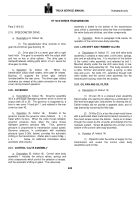TM-5-3805-254-14-P-2 - Page 697 of 894
TRUCK SERVICE MANUAL
HT 700D SERIES TRANSMISSIONS
Para 2-26
(7)
Movement
of
the
selector
valve
determines the highest gear which will be normally
reached automatically.
In drive 5 (D5), automatic 1-2, 2-
3, 3-4 and 4-5 shifts can occur.
In drive 4 (D4),
automatic 1-2, 2-3 and 3-4 shifts can occur.
In drive 3
(D3), automatic 1-2 and 2-3 shifts can occur.
In drive 1
(D1), no upshift can occur unless overspeed occurs.
Automatic downshifts can occur within the selected
ranges.
(8)
The various drive ranges limit the highest
gear attainable by introducing a pressure which prevents
rear governor pressure from upshifting the signal valves
(unless a governor pressure well above that normally
attained is reached).
This pressure is a regulated,
reduced pressure derived from main pressure at the hold
regulator valve.
Main pressure is directed to the hold regulator valve
through the hold feed line when the selector valve is at
drive 4 (D4), drive 3 (D3), or drive 2 (D2) position.
The
pressure produced in the hold regulator valve is directed
to the 4-5 shift signal valve when the selector valve is at
drive 4 (D4).
The hold pressure is directed to the 3-4
and 4-5 shift signal valves when the selector valve is at
drive 3 (D3) position.
With the selector valve in drive 2
(D2) position, the pressure is directed to the 2-3, 3-4 and
4-5 shift valves.
(9)
Hold regulator pressure at each shift
signal valve will push the upper valve upward, and raise
the pressure at which the lower valve will be pushed
upward by rear governor pressure.
Thus, when hold
regulator pressure is present, no upshift can occur at that
shift signal valve, except at an elevated speed.
q. Automatic Upshifts
(1)
When the transmission is operating in D5
a combination of rear governor pressure and modulator
pressure, or rear governor pressure alone, will upshift
the transmission to the next gear.
At closed, or part
throttle, modulator pressure exists and will assist rear
governor pressure.
At full throttle, there is no modulator
pressure.
Thus, upshifts occur sooner when the throttle
is closed; and is delayed by opening the throttle.
(2)
Rear governor pressure is dependent
upon the rotational speed of the transmission output.
The greater the output (vehicle) speed, the greater is
rear governor pressure.
When rear governor pressure is
sufficient, the first upshift (1-2) will occur.
A FURTHER INCREASE IN REAR GOVERNOR
PRESSURE WILL CAUSE A 2-3 UPSHIFT.
A further increase in rear governor pressure (and vehicle
speed) will cause a
3-4 upshift.
A still further
increase in rear governor pressure will cause a
’ 4-5
upshift.
Note that each of these upshifts will be either
delayed or hastened by the decrease or increase,
respectively of modulator pressure.
(3)
In other drive ranges, the same upshift
sequence occurs until the highest gear attainable in that
range selection is reached.
(4)
In any automatic upshift, the shift signal
valve acts first.
This directs a shift pressure to the relay
valve.
The relay valve shifts, exhausting the applied
clutch and applying a clutch for a higher gear.
690
TRANSMISSION
Back to Top




















